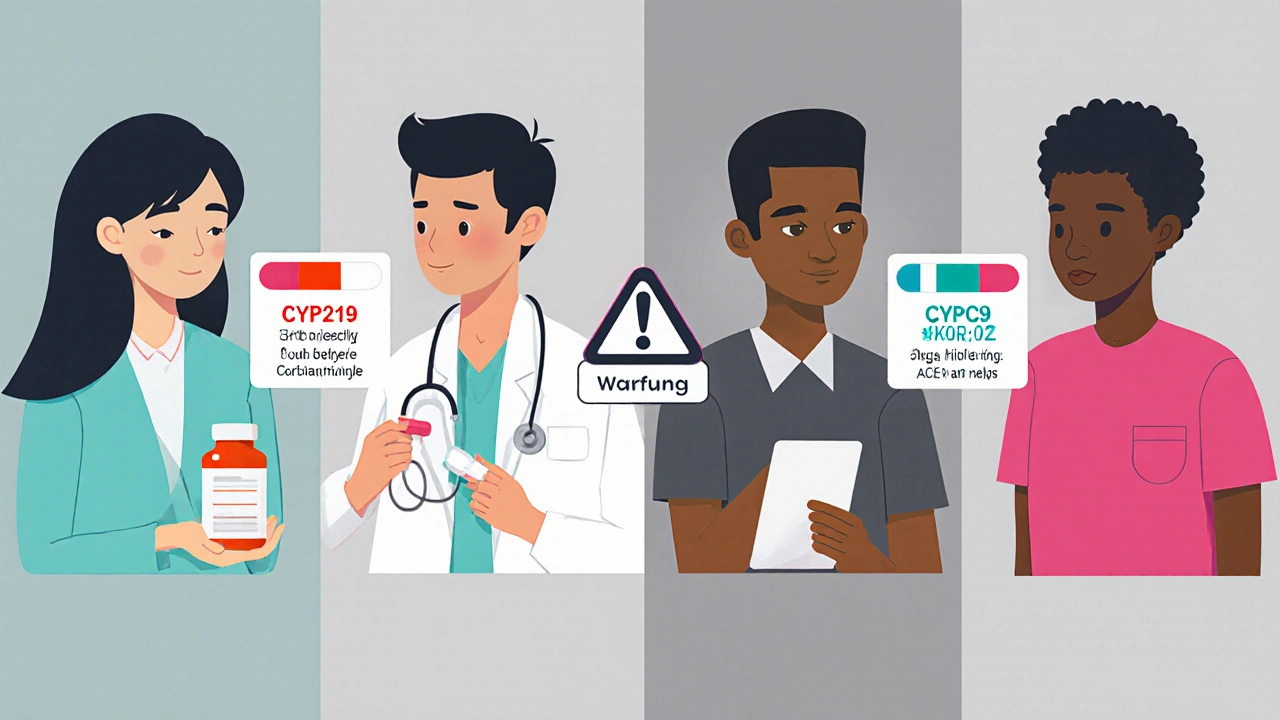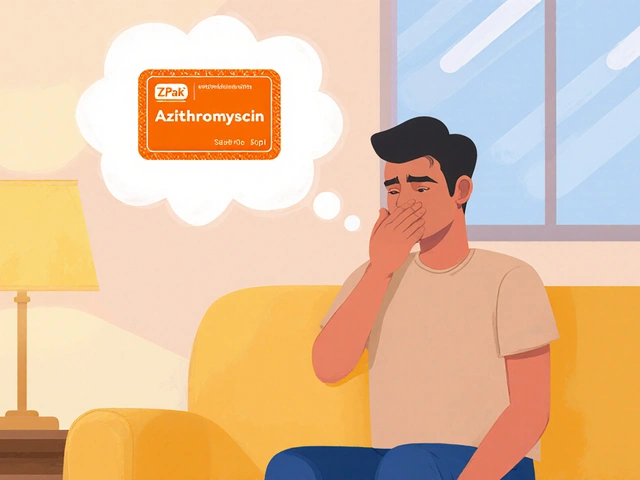
Pharmacogenomics Response Calculator
Ethnicity and Drug Response is the study of how genetic and metabolic differences across racial and ethnic groups influence medication efficacy and adverse effects. When a patient of Asian descent gets a prescription for carbamazepine and a Black patient gets an ACE inhibitor, the outcomes can be dramatically different - not because of culture, but because of DNA.
Why ethnicity matters in pharmacology
Pharmacogenomics emerged after the Human Genome Project showed that tiny DNA changes can rewrite how our bodies handle drugs. Roughly 20% of FDA‑approved drugs launched between 2009‑2015 showed clinically significant response differences among self‑identified racial and ethnic groups. While race is a social label, it often mirrors underlying genetic variation that affects drug‑metabolizing enzymes, transporters, and targets.
Key genetic players behind metabolic diversity
The cytochrome P450 family does the heavy lifting for about 70% of all prescribed medicines. The most studied isoforms-CYP2D6, CYP2C9, CYP2C19, and CYP3A4-carry alleles that vary in frequency across continents. These alleles create four metabolic phenotypes: poor, intermediate, normal, and ultrarapid metabolizers.
| Enzyme | Variant | African | European | East Asian | South Asian |
|---|---|---|---|---|---|
| CYP2C19 | *2 (loss‑of‑function) | 2‑5% | 3‑8% | 15‑20% | 12‑18% |
| CYP2D6 | *4/*5 (reduced function) | 8‑12% | 5‑7% | 3‑5% | 4‑6% |
| CYP3A5 | *3 (expressor) | 45‑55% | 10‑15% | 30‑40% | 25‑35% |
These percentages explain why an East Asian patient on clopidogrel may experience less platelet inhibition than a European patient-the drug needs CYP2C19 to become active.
Real‑world drug examples that highlight ethnic gaps
- Clopidogrel (antiplatelet): The CYP2C19*2 allele reduces activation. In East Asians, 15‑20% carry the allele, leading to higher rates of stent thrombosis unless a CYP2C19‑independent agent like ticagrelor is chosen.
- Carbamazepine (anticonvulsant): HLA‑B*15:02 dramatically raises the chance of Stevens‑Johnson syndrome. The allele appears in 10‑15% of Han Chinese, Thai, and Malaysian groups but is rare in Europeans. FDA recommends mandatory genetic testing for at‑risk Asian patients.
- Warfarin (anticoagulant): CYP2C9 and VKORC1 variants mean African‑American patients often need 20‑30% higher doses than European Americans. About 40% of African Americans carry CYP2C9 alleles not present in Europeans, making standard algorithms insufficient.
- ACE inhibitors (blood pressure): Clinical trials show a 30‑50% lower average blood‑pressure response in African Americans. The FDA approved isosorbide dinitrate/hydralazine specifically for self‑identified African‑American heart‑failure patients.
- Beta‑agonists for asthma: The ADRB2 Gly16Arg polymorphism varies from 25‑30% in Europeans to 50‑60% in African populations, influencing receptor down‑regulation and bronchodilator effectiveness.

Guidelines that translate genetics into prescribing
The Clinical Pharmacogenetics Implementation Consortium (CPIC) has published 27 gene‑drug guidelines, 14 of which flag ethnic considerations. For example, the CPIC clopidogrel guideline advises alternative therapy for CYP2C19 poor metabolizers, regardless of self‑identified race. The FDA now requires race/ethnicity stratification in most clinical trials, and 78% of new drug applications include pharmacogenetic data (2022).
When race becomes a double‑edged sword
Using self‑identified race as a shortcut can both help and hurt:
- Oversimplification: Two Nigerians and a Kenyan can differ more genetically than either does from a European, because African genetic diversity is huge.
- Missed risk: Asian patients without HLA‑B*15:02 have still suffered severe skin reactions to carbamazepine, showing that blanket testing based on ethnicity isn’t enough.
- Health disparities: Framing drug response as “race‑based” may reinforce bias and deter patients from participating in genetic testing.
Researchers like Dr. González Burchard argue that ancestry‑informative markers outperform race in predicting drug response. Ancestry‑based dosing models for warfarin and antihypertensives are already outperforming race‑based algorithms in pilot studies.
Practical steps for clinicians
- Screen high‑risk drugs: Order HLA‑B*15:02 testing before prescribing carbamazepine to patients of Asian descent.
- Use CPIC tools: Integrated electronic health record alerts can flag when a patient’s genotype suggests a dose change (e.g., CYP2C19 poor metabolizer on clopidogrel).
- Ask about ancestry: A brief questionnaire about parental origin can refine risk estimates beyond the “Asian” label.
- Educate patients: Explain that genetic testing is about safety, not about labeling them by race.
- Plan for cost: Comprehensive panels cost $1,200‑$2,500; work with insurers and consider targeted single‑gene tests when budgets are tight.

Future directions: From race to polygenic precision
Large initiatives like NIH’s All of Us program (3.5 million participants) are building a genomic reference that reflects true global diversity. By 2028, experts expect polygenic risk scores-combining 100‑500 variants-to improve drug‑dose accuracy by 40‑60% compared with current race‑based approaches. New FDA labels, such as the 2022 update for ivacaftor, now require a specific genetic test (CFTR mutation) instead of race‑based recommendations.
Challenges remain: only 19% of genome‑wide association studies include non‑European participants, and testing infrastructure is uneven (37% of U.S. hospitals offer comprehensive panels). Overcoming these gaps will need policy incentives, cheaper sequencing technology, and educational programs that move clinicians from “I treat based on race” to “I treat based on genotype and environment.”
Key takeaways
- Genetic polymorphisms, not race, drive most observed drug‑response differences.
- Major enzymes (CYP2C19, CYP2D6, CYP3A5) have allele frequencies that vary widely across ethnic groups.
- Guidelines (CPIC, FDA) increasingly favor genotype‑guided prescribing over ethnicity‑based heuristics.
- Clinicians should combine ancestry questionnaires, targeted genetic tests, and decision‑support tools for safe, effective therapy.
- The next wave of precision medicine will rely on polygenic scores and diverse genomic databases, reducing the need for race as a proxy.
Frequently Asked Questions
Is ethnicity a reliable predictor of drug response?
Ethnicity can give clues because certain genetic variants cluster in populations, but it is an imperfect proxy. Direct genetic testing provides far more accurate information for dosing and safety.
Which drugs absolutely require genetic testing before use?
Carbamazepine (HLA‑B*15:02), abacavir (HLA‑B*57:01), and certain fluoropyrimidines (DPYD variants) have FDA‑mandated or strongly recommended pre‑prescription tests. For clopidogrel, testing is recommended in patients who may be CYP2C19 poor metabolizers.
How does ancestry differ from race in clinical practice?
Ancestry refers to genetic lineage (e.g., West African, East Asian) measured by markers across the genome. Race is a social category that often blends many ancestries. Ancestry data can pinpoint the exact allele frequencies that matter for drug metabolism.
What are the biggest barriers to implementing pharmacogenomics?
Cost of testing, limited insurance coverage, lack of clinician training (average 10 hours needed), and under‑representation of non‑European groups in reference databases all slow adoption.
Will polygenic risk scores replace single‑gene tests?
Polygenic scores are poised to complement, not fully replace, single‑gene tests. They capture the cumulative effect of many variants, improving dose predictions for complex drugs like warfarin, but they still need robust validation across diverse populations.




Carla Taylor
October 24, 2025 AT 14:23Great overview thanks for sharing it really helps us see how genetics shape meds.
Kathryn Rude
October 31, 2025 AT 11:40One must admit that the reductionist view of race as a proxy for genotype borders on intellectual laziness yet the literature persists 🤔 the author could have delved deeper into polygenic risk scores
Amanda Vallery
November 7, 2025 AT 10:20Nice summary but watch out the table missing closing tag coud u fix it?
Marilyn Pientka
November 14, 2025 AT 09:00The reliance on self‑identified ethnicity in pharmacotherapy is a fundamentally flawed paradigm that perpetuates healthcare inequities; we must transition to ancestry‑informative marker (AIM) frameworks to mitigate pharmaco‑genomic discordance.
Jordan Levine
November 21, 2025 AT 07:40Wow this is exactly why America needs to fund its own genetic labs ASAP 🚀 stop borrowing data from Europe and start building home‑grown precision medicine infrastructure now!
Jacqueline Galvan
November 28, 2025 AT 06:20I appreciate your passion Jordan. While increased funding is essential, we also need policies that ensure equitable access to testing across underserved communities, not just rapid expansion.
Teya Arisa
December 5, 2025 AT 05:00Indeed, fostering both infrastructural investment and equitable rollout is paramount. 🌟 Collaborative frameworks involving public health agencies, insurers, and community stakeholders will be key.